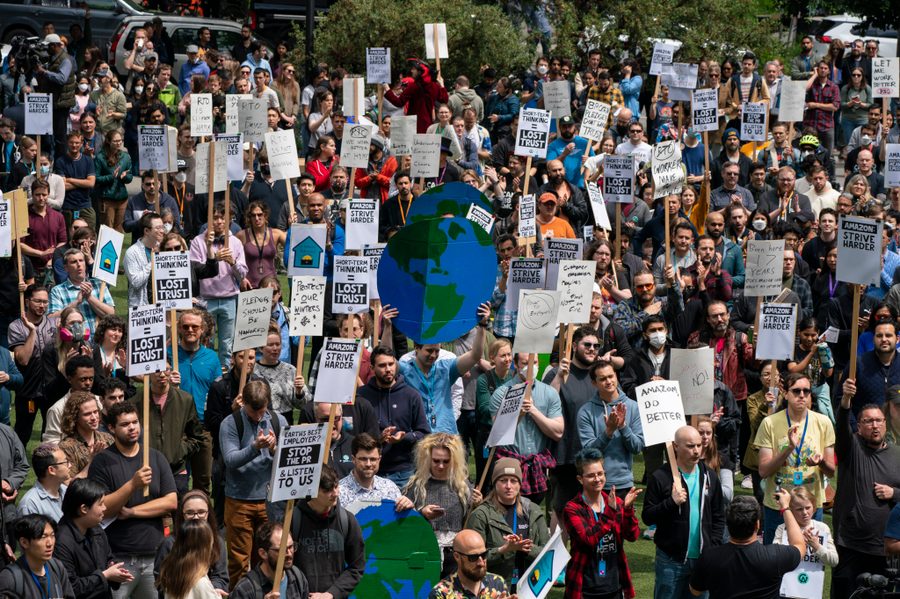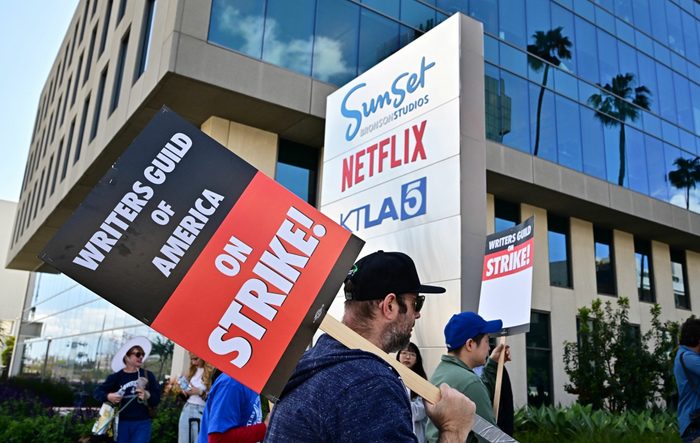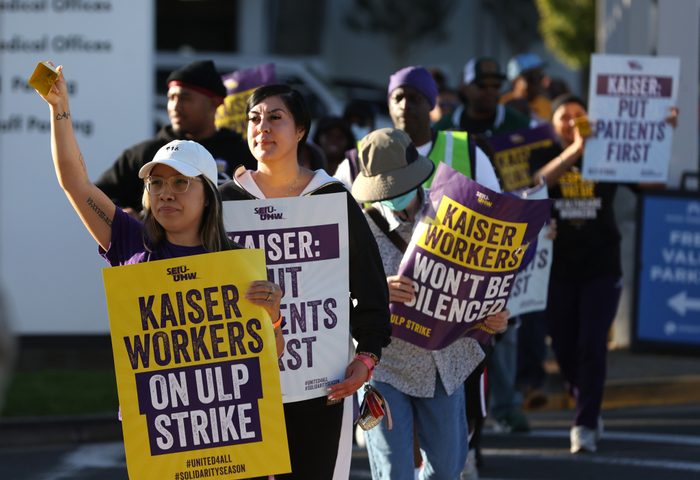2023 Was the Year of the Strike. What Can We Expect in 2024?
500,000 workers went out on strike in 2023. That’s twice as many as the year before.
Jenny Brown

Strikes and threats of strikes extracted contracts ranging from good to excellent from employers across the country this year. Half a million U.S. workers walked out — machinists, teachers, baristas, nurses, hotel housekeepers and autoworkers — with much of the motion coming from unions led by reformers.
The year started out with a squeaker of an election victory that turned out to be momentous. In late 2022, the Members United slate swept most top offices at the United Auto Workers (UAW) on a platform of “No Concessions, No Corruption, No Tiers.” March saw a presidential runoff pitting the old guard incumbent against an obscure Kokomo, Indiana, electrician and union rep named Shawn Fain. Among 140,000 votes cast, Fain won by a few hundred.
“Our job now is to put the members back in the driver’s seat, regain the trust of the rank and file and put the companies on notice,” he said then. “We are ending give-back unionism and company control in the UAW.”
Nine months later, the union’s Stand-Up Strike has notched sweeping victories against the Big Three, autoworkers in non-union plants are hustling to join, public opinion of striking workers is at a several-decade high and Fain is nearly a household name.
Strike threat worked
But the 150,000 Big Three autoworkers weren’t even the biggest workgroup to win thanks to new, more militant leadership. The 340,000 Teamsters at UPS notched their biggest contract gains ever by mounting a strike threat that reverberated through truck barns and warehouses across the country. Managers huddled nervously as UPSers marched into work together, galvanized by breakfast meetings and practice pickets.
The union’s new leaders, president Sean O’Brien and secretary-treasurer Fred Zuckerman, gave detailed reports on negotiations and bargained down to the wire, while the reform caucus that backed their 2022 election, Teamsters for a Democratic Union (TDU), spearheaded a program of shop-floor organizing and pickets. It was a winning combination that netted big wage gains and eliminated a second tier of drivers and a forced sixth workday.
Deep reform roots
The change in direction in both the Teamsters and the UAW has roots in reform caucuses that long argued for a struggle, not cuddle, approach to the companies.
In the Teamsters, the groundwork was laid in 1989 when the federal government threatened to take over the union due to corruption. TDU argued against government control. Instead, they said that democracy in the union — member control — would be the force that would end corruption. In a consent agreement, the union switched to one-member one-vote elections for top leaders, replacing the easily controlled elections held at conventions.
TDU-backed leaders won in 1991, lost in 1998 and won again in 2022, leading to a reinvigorated union, shop-floor mobilization and the believable strike threat that extracted huge gains from UPS this year.
A similar process, on a compressed timeline, happened with the autoworkers. In 2019, then president Gary Jones was removed from office and later pleaded guilty to embezzling union funds. He and his predecessor, Dennis Williams, were convicted and sent to prison along with a dozen others. A new reform caucus, Unite All Workers for Democracy, followed the TDU model, arguing with the feds that the answer to corruption was member control.
Unsurprisingly, in a referendum, UAW members voted to switch to a one-member, one-vote system. That set the stage for the UAWD-backed slate, Members United, to surprise everyone by winning the presidency and a majority on the executive board.
Strikes double
It wasn’t just Teamsters and the UAW, though. The half-million U.S. workers who struck in 2023 doubled the strike number for 2022, which in turn nearly doubled the 2021 number, according to Johnnie Kallas of the Cornell Labor Action Tracker. A similar number struck in 2018 during the “Red for Ed” teacher uprisings, but this year there were many more private-sector strikes, with actors, healthcare workers and autoworkers leading the way.
Polling showed an uptick in union popularity to levels not seen since the 1960s. Strikes were popular, too: 78% supported the autoworkers, and 76% the actors and writers.
The year started off with a victory for 7,000 New York nurses (NYSNA) who struck and won strong language to enforce safer staffing levels. Their hospitals now pay big penalties if they don’t keep enough nurses on the floor. Their victory inspired 1,700 nurses in New Jersey, members of the Steelworkers (USW), who have been on strike since August at Robert Wood Johnson hospital in New Brunswick.
In June, 6,000 machinists at Spirit AeroSystems in Wichita hit the bricks, rejecting an offer their union pushed. They were objecting to 60- and 70-hour weeks. They won their weekends back.
Hollywood the biggest
The biggest strike of the year was by 160,000 actors in SAG-AFTRA who walked out in July, following 11,000 screenwriters (WGA) to the strike line. Hollywood sputtered to a halt as familiar faces made cameos in TV news reports from the picket line. They stayed out for four months. Writers won gains on pay, staffing and sharing the bonanza from streaming.
In October, a coalition of unions including the SEIU struck West Coast healthcare giant Kaiser Permanente—75,000 people struck across four states, mostly in California. They won a 21% raise. Kaiser is under pressure from a new California law raising health care wages to a $25 minimum over the next 10 years.

In Los Angeles schools, support staff in Service Employees Local 99 walked out, and teachers followed: 65,000 in two unions striking together. Reformers run the teachers union in L.A. New leadership similarly led Portland educators to strike in November for three weeks.
At the Big Three, 50,000 autoworkers eventually struck in a strategically expanding action that caught the companies off guard. It started September 15 with one big plant of each of the Big Three: Ford, General Motors and Stellantis (formerly Chrysler). A week later, the union called out GM and Stellantis parts distribution centers, which supply profitable parts to dealerships. That got the companies’ attention. By expanding the strike at the companies that lagged and sparing those that were moving in the right direction, the union won contracts that abolished wage tiers and won life-changing raises for the lowest-paid. While autoworkers didn’t make up for all the concessions of the last 30 years, they took big strides.
The award for most strikes surely goes to Los Angeles this year. In addition to the schools and the actors and writers, 15,000 UNITE HERE members have been on rolling short strikes at 62 hotels. Out-of-control housing prices mean hotel workers are commuting two hours each way, or living in their cars during the week, because they can’t afford to live closer to their jobs.
Defense against tech
Self-defense against changing tech was a recurring theme. At UPS, the new contract abolishes driver-facing surveillance cameras and forms a tech committee to approve changes. Actors and writers beat back the AI-assisted theft of their work.
Automakers have been using the transition to electric vehicles (EVs) to undermine wages. Before the strike, union battery plant workers, who face dirty work and hazardous conditions, occupied a lower-paid tier. But with the new contract, union workers at GM’s joint-venture battery plant Ultium Cells saw their top hourly rate immediately rise from $20 to $32.
Astonishingly, the union got GM and Stellantis to put new battery plants under the national contracts — even ones that are still being built or planned. At Ford, the union will still have to organize these factories, but it won neutrality agreements. “We’ve been told the EV future must be a race to the bottom,” said Fain. “We called their bluff.”
In Las Vegas, the culinary union (UNITE HERE) of hotel housekeepers and casino and restaurant workers, plus a separate local of bartenders, raised a strike threat with escalating marches and sit-ins. At the last minute, the three biggest properties agreed to major demands, including daily room cleaning. This defeated a speed-up: The hotels had begun ordering housekeepers to clean rooms only at the end of a stay, meaning each room took much more work to clean, without reducing their daily room quota.
Union ‘Yes, please!’
Often, union organizers are told that striking is scary — a topic to downplay. But the opposite is proving to be the case: A powerful strike is a great recruiting tool.
Since the Stand-Up Strike, hundreds of workers at non-union auto plants have been contacting the UAW to organize. At the Chattanooga, Tenn., Volkswagen plant, workers signed 1,000 cards in a week.
Workers across the economy have been clamoring to organize. The United Electrical Workers (UE) have scored a series of blowout votes to unionize among graduate workers — adding 14,000 members. At Northwestern, Johns Hopkins and the University of Chicago, they won by more than 90%. At the University of Minnesota, they won by 97%, in a unit that had voted down union efforts in 2005 and 2012; wages and health care were the top issues. Five thousand National Institutes of Health research fellows voted UAW yes by 97.8% in December.
The steelworkers won an important southern manufacturing victory in May at Blue Bird Bus, where 1,400 workers build buses near Macon, Georgia. And at Kumho Tire in Macon, 300 steelworkers who build tires signed a first contract, after a bruising three-year campaign for union recognition and a two-year contract fight. It is the first tire company to unionize in the United States in 40 years.
A thousand workers at DHL Express at the Cincinnati-Northern Kentucky airport joined Teamsters Local 100 after a year-long fight. They went on strike Dec. 7. Cincinnati is the company’s largest North American hub.
Starbucks Workers United continued a steady drumbeat of election wins, organizing 360 stores in two years. The company has used illegal tactics throughout the campaign, like firing union supporters and excluding union stores from credit-card tipping. The courts have found Starbucks guilty of hundreds of violations and ordered it to reinstate dozens of fired workers and stop punishing union stores. Still, the company has stalled negotiations and not a single store has a contract yet.
Workers at Trader Joe’s, organizing with the independent Trader Joe’s United, have voted union at stores in Massachusetts, Kentucky, Minnesota and California. The company has delayed in negotiations and is now trying to decertify the union at the Hadley, Mass., store that was the first to unionize.
Amazon has refused even to start negotiations with its union workers, using a combination of illegal repression, appeals and delay against the 7,000 workers at JFK8 in Staten Island who voted to join the Amazon Labor Union in 2022.
Meanwhile, Amazon delivery drivers in Palmdale, Calif., who joined the Teamsters have been on an unfair labor practice strike for six months, ever since Amazon illegally terminated them by canceling its contract with their nominal employer BTS — a legal fiction designed to protect Amazon from accountability.
All this organizing is creating pressure to strengthen labor law, and the Democrat-dominated NLRB has been cranking out favorable rulings. Stericycle takes aim at company rules that chill organizing. Under the Cemex decision, if an employer commits an unfair labor practice so egregious that it would necessitate another union election, the employer will automatically have to recognize the union (assuming the union filed with majority support). That would have helped in the Kumho Tire drive, where a revote added years of delays.
Biden’s NLRB General Counsel Jennifer Abruzzo is clearly trying to enforce the law; fired Starbucks workers, for example, have been able to get their jobs back. But deep-pocketed companies are still getting away with a strategy that Kallas at Cornell called, “Litigate, litigate, litigate. Delay, delay, delay.”

A vital cycle
A theme this year is that reform movements led to bolder contract demands, which led to winning contract campaigns and strikes, which are giving workers hope in new organizing.
Inspired by good examples, the renovating spirit is sparking to life in more and more unions. There’s already a sizable reform pole in the 1.2 million-member food and commercial workers (UFCW) centered in the union’s biggest local. Rail machinist reformers look set to finally win a challenged election in the 7,500-member District Lodge 19, which represents rail mechanics all over the country. A new caucus, CREW, has emerged in the Theatrical and Stage Employees (IATSE). And potential new organizing in the auto sector could change the country.
It all adds up to an exciting prospect as we enter 2024.
Labor Notes staff contributed reporting to this article all year.
This story was originally published by Labor Notes.







